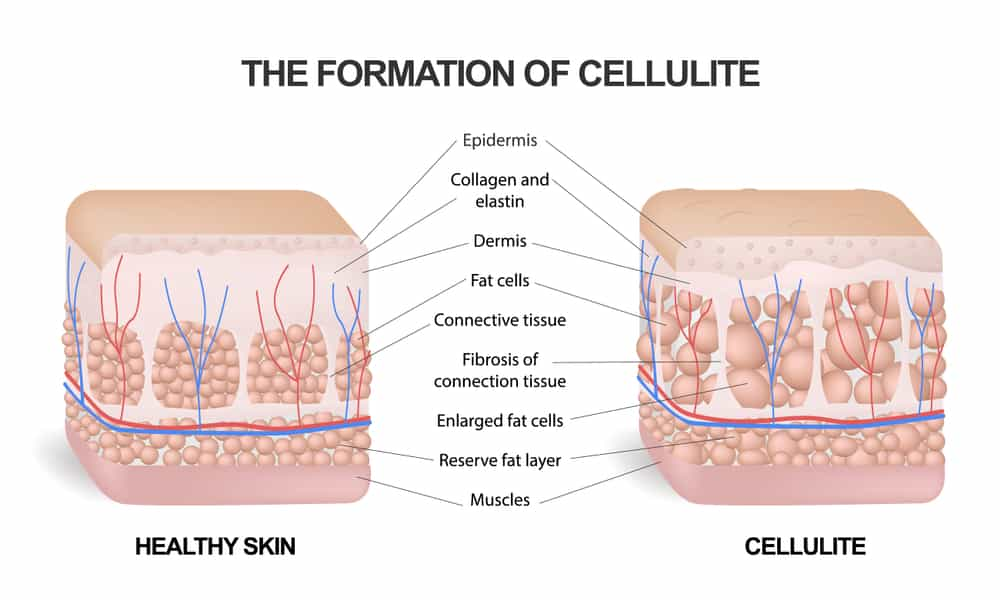How Do Anti-Cellulite Creams Work?

Cellulite
Open any women's magazine and you'll see advertisements for anti-cellulite lotions that promise to reduce the spongy, dimply, cottage cheese-looking skin that so many women hate. Caffeine, retinol, and the antioxidant DMAE are highlighted as specific components that help minimize the appearance of cellulite, which appears on the hips, thighs, and buttocks of millions of women during adolescence.

Cellulite Is the Norm
Cellulite is a pattern of superficial fat storage. Instead of fat being deposited diffusely, it is stored in small pockets divided by fibrous strands called septae. Cellulite is not caused by pollutants, poor circulation, or congested lymphatics, contrary to what patients have heard or read. In fact, one study comparing cellulite fat to regular fat found no molecular differences. If patients wish to try something other than diet and exercise to get rid of cellulite, we recommend starting with a low-cost cream and giving it eight weeks to work.
One doctor stated that he has heard anecdotally from his patients that the creams help reduce the look of cellulite, but there is no medical evidence to support this claim.
In theory, cream ingredients like methylxanthine—caffeine is one type of it—are molecules that prevent fluid retention, which can exacerbate cellulite. However, there is an absence of medical evidence that the products can be absorbed deeply into the fat via the skin's surface.
How Does Cellulite Create Dimply Skin?
Contrary to popular opinion, cellulite is not merely fat beneath the surface of our skin. Cellulite occurs when strong, fibrous septae stretching from the deep connective tissue layer to [the] muscle pull down on [fat cells], trapping fat into distinct pockets, explains Mara Weinstein Velez, a general and cosmetic dermatologist at Schweiger Dermatology Group in New York. These fat pockets, which are most commonly found on the buttocks, thighs, and hips, translate into the dimples we perceive on the skin's surface.
While cellulite affects practically everyone, specialists say it is more visible in women due to the direction in which the fibrous bands run over the body. "The fat cells and connective tissue in this layer are organized vertically in women." Cellulite arises when those fat cells protrude through the skin's layer. The tissue in men has a crisscross structure, which may explain why men are less likely than women to get cellulite.
Of course, whether or not you have cellulite is determined by your genetics and how hormones affect your body. Cellulite is caused by a combination of hormones such as estrogen, insulin, noradrenaline, thyroid hormones, and prolactin. According to Beverly Hills dermatologist Jason Emer, hormone changes such as those induced by pregnancy, irregular periods, or birth control, as well as age, can affect how firm the skin is, making cellulite more or less visible.
Topical Ingredients that Work (And How Effective They Are)
Cellulite develops when the connective fibers (formed of collagen) that connect your muscles and skin press fat cells toward your epidermis, resulting in a bumpy, dimpled look. One of these two topicals has evidence that they work for cellulite, one of which is retinol. Tretinoin (a Vitamin A derivative) is contained in Retin-A, Tazorac, and 1% Differin gel and "may aid since they can increase collagen formation and reduce the appearance of cellulite."
The American Academy of Dermatology recommends that lotions and creams have at least 0.03 percent retinol, but most don't specify the proportion on the label. According to Dermstore, this suggests the concentration is most likely less than 0.25 percent. Caffeine-related topicals may also be effective in reducing the appearance of cellulite. They shrink fat cells and accelerate the breakdown of fibrous bands of connective tissue. If you don't see caffeine stated on cellulite-reducing products, look for methylxanthine, which contains caffeine, aminophylline, and theophylline.
Can You Get Rid of Cellulite Completely?
Cellulite affects people of all shapes and sizes. Although this is natural, the way fat pulls on your connective tissue causes it to appear puckered or dimpled. It cannot be entirely removed, but there are methods for improving its appearance.
What Are the Best Cellulite Creams on the Market?
Up to 98 percent of women have cellulite, compared to only 10 percent of men. Given the size of this group, it makes sense that there are a ton of expensive products on the market that make outlandish claims. Thousands of customers vouch for some of them to momentarily lessen the severity of their stretch marks and cellulite. Discover the elements that will enable you to expand your bliss! These firming, moisturizing, and toning body creams are in short supply even at your neighborhood pharmacy! Proven ingredients in anti-cellulite lotions include caffeine, retinol, collagen, Vitamin C, Vitamin E, fistein, peptides, and l-carnitine.
Three cellulite creams contain one or more of the ingredients that should enable you to achieve your goals. The three best cellulite creams are Procellix, Revitol, and Dermology. A clinical study of the cellulite cream Procellix revealed that it was effective for at least 95% of those who used it. According to their reports, the participants' cellulite was greatly decreased. Benefits from this cream may be seen in as little as a few weeks.
Any area of your body may be treated with Revitol, a supplement. Additionally, it aims to increase collagen production in your body. When used properly, it ought to increase skin suppleness. A cellulite cream is made to absorb quickly into the skin. Additionally, this cream should tighten your skin and lessen the look of cellulite.
Another great cellulite cream is the Celluaid cellulite cream, one of the top cellulite creams on the market by CelluAid, a well-known American company. Customers are provided with a very powerful body treatment for the stomach, thighs, and other cellulite-prone areas of the body.
Cellulite Cream:
Cellulite creams are an example of a topical therapy or cosmetic for cellulite. Cellulite creams contain caffeine, retinol, carnitine, forskolin, and other plant compounds. Caffeine could be replaced with aminophylline or theophylline (a prescription asthma medicine). Cellulite creams have a broad therapeutic impact due to adipocyte tissue lipolysis, stimulation of peripheral microcirculation, which assists lymphatic drainage, and edema reduction. Specific chemicals have the following impacts:
Caffeine: By controlling biological second messenger systems, caffeine breaks down fat cells. An enzyme called triglyceride lipase helps break down triglycerides into free fatty acids and glycerol.
Anti-adipogenic medications that inhibit the differentiation of human adipocyte precursors Additionally, it raises collagen levels. This improved the skin's elasticity and tensile strength as well as thickness.
Three potent botanicals—Ginkgo biloba, Centella asiatica, and Horse Chestnut—slow lipogenesis, promote fat breakdown, and serve as antioxidants and anti-inflammatory agents.
You might experience some skin burning as a result of these components and mixtures, but do not be alarmed; this simply indicates that the cream is doing its job. The lumpy fat under the skin should be burned by the anti-cellulite lotion, so it might burn a little.

So, Are Creams Worth the Money?
The most effective and long-lasting results come from intrusive procedures. "There isn't really much you can do in terms of topical therapies." Various creams, including those containing caffeine and retinol, have been utilized, but none of them have demonstrated any appreciable advantages. While utilizing over-the-counter lotions, creams, and serums appears to be the less expensive alternative, you'd need to apply them frequently over a lengthy period of time to notice even a small, temporary reduction in the cottage cheese-like appearance of cellulite.





